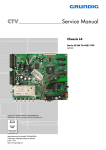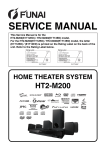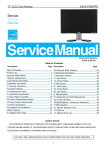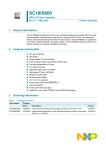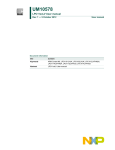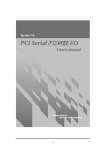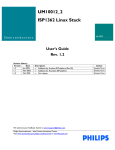Download Philips ISP1301 User's Manual
Transcript
UM10028_1 ISP1301 USB OTG Transceiver Eval Kit User’s Guide February 2003 User’s Guide Rev. 1.0 Revision History: Version Date 1.0 Feb 2003 Descriptions First release We welcome your feedback. Send it to [email protected]. Philips Semiconductors - Asia Product Innovation Centre Visit www.semiconductors.philips.com/buses/usb or www.flexiusb.com Author David Wang Philips Semiconductors ISP1301 USB OTG Transceiver Eval Kit User’s Guide This is a legal agreement between you (either an individual or an entity) and Philips Semiconductors. By accepting this product, you indicate your agreement to the disclaimer specified as follows: DISCLAIMER PRODUCT IS DEEMED ACCEPTED BY RECIPIENT. THE PRODUCT IS PROVIDED “AS IS” WITHOUT WARRANTY OF ANY KIND. TO THE MAXIMUM EXTENT PERMITTED BY APPLICABLE LAW, PHILIPS SEMICONDUCTORS FURTHER DISCLAIMS ALL WARRANTIES, INCLUDING WITHOUT LIMITATION ANY IMPLIED WARRANTIES OF MERCHANT ABILITY, FITNESS FOR A PARTICULAR PURPOSE, AND NONINFRINGEMENT. THE ENTIRE RISK ARISING OUT OF THE USE OR PERFORMANCE OF THE PRODUCT AND DOCUMENTATION REMAINS WITH THE RECIPIENT. TO THE MAXIMUM EXTENT PERMITTED BY APPLICABLE LAW, IN NO EVENT SHALL PHILIPS SEMICONDUCTORS OR ITS SUPPLIERS BE LIABLE FOR ANY CONSEQUENTIAL, INCIDENTAL, DIRECT, INDIRECT, SPECIAL, PUNITIVE, OR OTHER DAMAGES WHATSOEVER (INCLUDING, WITHOUT LIMITATION, DAMAGES FOR LOSS OF BUSINESS PROFITS, BUSINESS INTERRUPTION, LOSS OF BUSINESS INFORMATION, OR OTHER PECUNIARY LOSS) ARISING OUT OF THIS AGREEMENT OR THE USE OF OR INABILITY TO USE THE PRODUCT, EVEN IF PHILIPS SEMICONDUCTORS HAS BEEN ADVISED OF THE POSSIBILITY OF SUCH DAMAGES. UM10028_1 User’s Guide © Koninklijke Philips Electronics N.V. 2003. All rights reserved. Rev. 1.0—February 2003 2 of 18 Philips Semiconductors ISP1301 USB OTG Transceiver Eval Kit User’s Guide CONTENTS 1. INTRODUCTION ............................................................................................................................... 5 2. SYSTEM REQUIREMENTS................................................................................................................ 5 3. CONFIGURATIONS AND SETTINGS............................................................................................ 6 3.1. 3.2. 3.3. 3.4. 3.5. POWER REQUIREMENTS ......................................................................................................................................................6 I2C MASTER SELECTION ......................................................................................................................................................6 USB INTERFACE ..................................................................................................................................................................7 AUDIO INTERFACE ..............................................................................................................................................................7 RESET ...................................................................................................................................................................................7 4. LOCATION OF MAJOR COMPONENTS ....................................................................................... 7 5. TEST PROGRAM 1301.EXE .............................................................................................................. 8 5.1. INTRODUCTION..................................................................................................................................................................8 5.2. RUNNING THE TEST PROGRAM ..........................................................................................................................................9 5.3. USING MENUS ......................................................................................................................................................................9 5.3.1. Choose I2C slave address for ISP1301..................................................................................................................................9 5.3.2. Reset all registers .........................................................................................................................................................................9 5.3.3. List all registers .......................................................................................................................................................................... 10 5.3.4. Read/Write register .................................................................................................................................................................. 10 5.3.5. Select Mode of Operation....................................................................................................................................................... 11 5.3.6. Enable/Disable charge-pump................................................................................................................................................. 11 6. HARDWARE DESCRIPTION..........................................................................................................12 6.1. BLOCK DIAGRAM ..............................................................................................................................................................12 6.2. FUNCTIONAL DESCRIPTION .............................................................................................................................................12 6.2.1. PCF8584 I2C-bus controller .................................................................................................................................................... 12 6.2.2. PC parallel to I2C converter .................................................................................................................................................... 12 6.2.3. HC, DC and OTG core logic interface connector ............................................................................................................. 12 6.2.4. Power manager.......................................................................................................................................................................... 13 6.2.5. Audio interface........................................................................................................................................................................... 13 7. CONNECTOR PIN INFORMATION..............................................................................................13 7.1. 7.2. 7.3. DB-25 PC PARALLEL PORT CONNECTOR (J10) PIN ASSIGNMENT ...............................................................................13 8-BIT MICROPROCESSOR INTERFACE 20 X 2 HEADER (J13) PIN ASSIGNMENT .............................................................13 USB OTG CONTROLLER INTERFACE 8 X 2 HEADER (J8 AND J3) PIN ASSIGNMENT .................................................13 8. SCHEMATICS OF THE EVALUATION BOARD .........................................................................14 9. BILL OF MATERIALS.......................................................................................................................17 10. REFERENCES ....................................................................................................................................18 UM10028_1 User’s Guide © Koninklijke Philips Electronics N.V. 2003. All rights reserved. Rev. 1.0—February 2003 3 of 18 Philips Semiconductors ISP1301 USB OTG Transceiver Eval Kit User’s Guide TABLES Table 3-1: +5.0 V power selection.......................................................................................................................................................................... 6 Table 3-2: VBAT and VIO selection .............................................................................................................................................................................. 6 2 Table 3-3: I C master selection................................................................................................................................................................................ 6 Table 7-1: DB-25 PC parallel port connector (J10) pin assignment ..............................................................................................................13 Table 7-2: 8-bit microprocessor-interface 20 x 2 header (J13) pin assignment[1] .......................................................................................13 Table 7-3: OTG Controller interface J8 pin assignment ..................................................................................................................................14 Table 7-4: OTG Controller interface J3 pin assignment ..................................................................................................................................14 Table 9-1: BOM of the ISP1301 evaluation board .............................................................................................................................................17 FIGURES Figure 1-1: ISP1301 evaluation board PCB layout ............................................................................................................................................... 5 Figure 4-1: Location of major components........................................................................................................................................................... 8 Figure 5-1: Test program main menu ..................................................................................................................................................................... 9 Figure 5-2: List all registers screen display ..........................................................................................................................................................10 Figure 5-3: Read/Write register screen display..................................................................................................................................................11 Figure 5-4: Select Mode of Operation screen display.......................................................................................................................................11 Figure 6-1: Block diagram of the ISP1301 evaluation board............................................................................................................................12 Microsoft and Windows are registered trademarks of Microsoft Corp. Intel is a registered trademark of Intel, Inc. The names of actual companies and products mentioned herein may be the trademarks of their respective owners. All other names, products, and trademarks are the property of their respective owners. UM10028_1 User’s Guide © Koninklijke Philips Electronics N.V. 2003. All rights reserved. Rev. 1.0—February 2003 4 of 18 Philips Semiconductors ISP1301 USB OTG Transceiver Eval Kit User’s Guide 1. Introduction The ISP1301 is a Universal Serial Bus (USB) On-The-Go (OTG) transceiver device that is fully compliant with Universal Serial Bus Specification Rev. 2.0 and On-The-Go Supplement to the USB 2.0 Specification Rev. 1.0. It integrates a USB full-speed and low-speed transceiver, and other analog components to fully support OTG functionality. The ISP1301 is ideal for use in portable electronics devices, such as mobile phones, personal digital assistants (PDAs), digital still cameras, and digital audio players. The ISP1301 acts as a physical layer to interface with any USB OTG Controller. The ISP1301 evaluation board is designed to evaluate the functions of the ISP1301 chip. The main components on the board are: the ISP1301 (in HVQFN24 package), I2C master, USB mini-AB connector, analog audio interface, and USB OTG controller interface. The operation mode of the ISP1301 can be configured through the I2C interface. The OTG status and control registers in the ISP1301 can also be accessed through the I2C interface. To verify the functions of the ISP1301 by using the DOS test program that is provided with the evaluation kit, connect the ISP1301 evaluation board to the parallel port of a PC. To fully verify the functions of the ISP1301, a USB OTG controller is used to connect to the ISP1301 board through the defined interface connector. Figure 1-1: ISP1301 evaluation board PCB layout 2. System requirements An x86 PC with DB-25 parallel port is required. The test program runs on DOS (or the command line in Microsoft® Windows® 98). In the BIOS setting, select port address 378H for the onboard parallel port. The test program is compiled using Turbo® C++ 3.0. UM10028_1 User’s Guide © Koninklijke Philips Electronics N.V. 2003. All rights reserved. Rev. 1.0—February 2003 5 of 18 Philips Semiconductors ISP1301 USB OTG Transceiver Eval Kit User’s Guide 3. Configurations and settings 3.1. Power requirements By default, the ISP1301 board is powered by a +5.0 V power supply through the DC jack (J12, inner +). The +5.0 V power can also be supplied from the USB Type-B connector (J4). However, when J4 is connected to a USB port on the PC, leave the USB mini-AB connector (J9) unconnected. If an external microprocessor is used to control the I2C controller chip PCF8584 (U4), the +5.0 V power can also be supplied from pin 16 and pin 18 of the microprocessor connector (J13). When the +5.0 V power is correctly applied to the board, LED2 (green) will turn ON. Table 3-1: +5.0 V power selection Jumper JP6 Descriptions Short 1(UP5V) and 2 (+5V): +5.0 V from the microprocessor interface (pin 16 or 18 of J13) Short 3 (H_VBUS) and 4 (+5V): +5.0 V from the VBUS line of the USB connector (pin 1 of J4) Short 5 (EXT5V) and 6 (+5V): +5.0 V from the DC jack (J12, inner +) [default] The power supply (VBAT pin) for the ISP1301 can be provided either from the onboard +3.3 V source or from the OTG Controller interface (pin 2 of J3). Similarly, the power supply for the VIO (called VDD_LGC in the ISP1301 datasheet) pin of the ISP1301 can be provided either from the onboard +3.3 V source or from the OTG Controller interface (pin 2 of J8). Table 3-2: VBAT and VIO selection Jumper JP2 JP5 3.2. Descriptions Short: VBAT from the onboard +3.3 V source [default] Open: VBAT from the pin 2 of J3 Short: VIO from the onboard +3.3 V source [default] Open: VIO from the pin 2 of J8 I2C master selection The I2C master controller can be supplied from any one of three sources: • PC parallel port (software I2C master) • Philips I2C controller chip PCF8584 (hardware I2C master) • External I2C master that is connected to the I2C header J11. 2 Table 3-3: I C master selection Jumper JP3 JP4 Descriptions Short 1 (SDA_8584) and 2 (SDA5V): SDA from PCF8584 Short 2 (SDA5V) and 3 (SDA_PC): SDA from PC parallel port [default] Open: SDA from I2C connector (pin 4 of J11) Short 1 (SCL_8584) and 2 (SCL5V): SCL from PCF8584 Short 2 (SCL5V) and 3 (SCL_PC): SCL from PC parallel port [default] Open: SCA from I2C connector (pin 3 of J11) Note: SCL and SDA come from the same I2C master. UM10028_1 User’s Guide © Koninklijke Philips Electronics N.V. 2003. All rights reserved. Rev. 1.0—February 2003 6 of 18 Philips Semiconductors 3.3. ISP1301 USB OTG Transceiver Eval Kit User’s Guide USB interface There are three USB connectors on the ISP1301 evaluation board. • If an OTG Controller is connected to the ISP1301, the USB port functions as an OTG dual-role device and only the mini-AB connector (J5) will be used. • If a Host Controller is connected to the ISP1301, the USB port functions as a host and only the Type-A connector (J1) will be used. • If a Device Controller is connected to the ISP1301, the USB port functions as a device and only the TypeB connector (J4) will be used. You can use all the three ports at the same time. If you have a system that consists of a USB host port and a separate device port, then the host port can be connected to J4 and the device port can be connected to J1 using the standard USB cable. In such a case, the ISP1301 provides only OTG functions to the system; the transceiver function of the ISP1301 is not used. 3.4. Audio interface The ISP1301 evaluation board has an interface to support an analog audio carkit application. Connect: • • • 3.5. The audio carkit to the mini-AB connector (J9) on the board; The audio input line signal to the SPK LINE IN socket (J6) on the board; The audio output line signalto the MIC LINE OUT socket (J7) on the board. Reset For a hardware reset to the ISP1301, press the manual reset switch (SW1). The reset pulse (active LOW) can also come from the OTG Controller interface (pin 8 of J3). 4. Location of major components Figure 4-1 shows the location of major components on the evaluation board. UM10028_1 User’s Guide © Koninklijke Philips Electronics N.V. 2003. All rights reserved. Rev. 1.0—February 2003 7 of 18 Philips Semiconductors ISP1301 USB OTG Transceiver Eval Kit User’s Guide J6 J7 JP3 J12 JP5 JP4 JP1 J 2 J10 J11 JP2 J8 J 5 U1 J3 SW1 J9 J1 JP6 J13 U4 J4 ISP1301 EVALUATION BOARD REV 1.0 Figure 4-1: Location of major components 5. Test program 1301.EXE 5.1. Introduction A DOS test program “1301.exe” is provided to help you verify the functions of the ISP1301 chip. The program uses the PC parallel port to access the ISP1301 registers through the I2C interface. The program simulates software I2C master at the hardware abstraction layer (HAL). The test program can do the following: • Set the I2C slave address for the ISP1301 based on the hardware setting of the ADR pin • Reset all registers to their default values • Display the current value of all registers on your PC screen • Write any value to a writable register • • Set the mode of operation of the ISP1301 (such as, USB function and suspend mode, transparent I2C mode, transparent general-purpose buffer mode, and global power-down mode) Enable or disable the charge pump of the ISP1301. UM10028_1 User’s Guide © Koninklijke Philips Electronics N.V. 2003. All rights reserved. Rev. 1.0—February 2003 8 of 18 Philips Semiconductors 5.2. ISP1301 USB OTG Transceiver Eval Kit User’s Guide Running the test program If your PC boots to pure DOS, run the test program on the command line. If your PC boots to Microsoft Windows 98, open an MS-DOS window and run the test program. It is recommended that you boot the PC to pure DOS. To run the test program, type 13011 and press the Enter key at the command prompt. Note: In the BIOS setting of the PC, the I/O address for the onboard parallel port is 378H. 5.3. Using menus After the program has been launched, the main menu will appear on the screen. See Figure 5-1. Figure 5-1: Test program main menu In the main menu screen, selecting any item 1–6 will perform the desired action. If you wish to exit the program, press the Esc key. The following sections describe the menu items. 5.3.1. Choose I2C slave address for ISP1301 The program will prompt you to enter your choice based on the hardware setting of the ADR pin. • If ADR is HIGH, select 1. The slave address for the ISP1301 will become 0x5A. • If ADR is LOW, select 0. The slave address for the ISP1301 will become 0x58. Make sure that choices are done correctly; otherwise, other operations may fail. If you set the ISP1301 to the transparent I2C mode and choose a slave address value other than the value set here, you must set it back to the original slave address when you revert to the direct I2C mode. 5.3.2. Reset all registers On selecting this option, the program will set all the registers—excluding the read-only registers—to their default values and display these values on your PC screen. 1 In this document, items that you type or click are indicated in bold. UM10028_1 User’s Guide © Koninklijke Philips Electronics N.V. 2003. All rights reserved. Rev. 1.0—February 2003 9 of 18 Philips Semiconductors 5.3.3. ISP1301 USB OTG Transceiver Eval Kit User’s Guide List all registers On selecting this option, the program will display all the 22 registers on the screen. See Figure 5-2. Figure 5-2: List all registers screen display 5.3.4. Read/Write register The program will display the current value of all registers and prompt you to write to a specific register. On selecting item 4 from the main menu, the program will display the screen given in Figure 5-3. The program will prompt you to type the address of the register whose value you want to change. On entering the address of the register and pressing Enter, the program will prompt you to enter the new value that you want to assign. If you want to return to the main menu, type FF at the command prompt. UM10028_1 User’s Guide © Koninklijke Philips Electronics N.V. 2003. All rights reserved. Rev. 1.0—February 2003 10 of 18 Philips Semiconductors ISP1301 USB OTG Transceiver Eval Kit User’s Guide Figure 5-3: Read/Write register screen display 5.3.5. Select Mode of Operation You can select the mode of operation of the ISP1301 by selecting item 5 from the main menu. A submenu will appear on the screen. See Figure 5-4. The possible choices include the USB functional mode (four data encoding and decoding methods), transparent I2C mode, transparent buffer mode, USB suspend mode, and global powerdown mode. Note: If the ISP1301 Engineering Sample 1 (ES1) (that is, the chip whose version register reads 0x0100, or the chip package is marked ####AX) is mounted on the evaluation board, software cannot wake up the chip, if set to the global power-down mode. Only a hardware reset can wake up the chip. Figure 5-4: Select Mode of Operation screen display 5.3.6. Enable/Disable charge-pump If the charge pump in the ISP1301 is disabled, selecting menu item 6 will enable the charge pump. If the charge pump is enabled, selecting menu item 6 will disable it. UM10028_1 User’s Guide © Koninklijke Philips Electronics N.V. 2003. All rights reserved. Rev. 1.0—February 2003 11 of 18 Philips Semiconductors ISP1301 USB OTG Transceiver Eval Kit User’s Guide 6. Hardware description 6.1. Block diagram Figure 6-1 shows the block diagram of the ISP1301 evaluation board. PARALLEL PC PARALLEL-TO-I2 C CONVERTER 4-PIN I2 C HEADER PCF8584 I 2 C-BUS CONTROLLER ISA DP, DM, ID I2C-BUS (SCL, SDA, ADR, INT) AUDIO INTERFACE (L/R SPEAKER LINE IN, MIC PRE-AMP OUT) DP, DM, ID, V BUS VBUS ISP1301 OTG TRANSCEIVER m ini-AB Receptacle CORE INTERFACE (OE, VP, VM, RCV, SPEED, SUSPEND, RESET, V DD_LGC ) V BAT POW ER MANAGER Vext FPGA INTERFACE HC, DC and OTG CORE LOGIC INTERFACE CONNECTOR (to the ISP1362 FPGA or Phone FPGA) Figure 6-1: Block diagram of the ISP1301 evaluation board 6.2. Functional description A brief description of each function module is given in the following sections. 6.2.1. 2 PCF8584 I C-bus controller This block provides functions of the I2C-bus to the 8-bit parallel-bus converter. It can connect to the Philips ISP1362 or ISP1161x ISA interface board, or any other generic 8-bit microprocessor interface through a 40-wire IDE cable. The PC or other microprocessor can service the interrupt from the ISP1301 and access the registers of the ISP1301 through this interface. 6.2.2. 2 PC parallel to I C converter This interface provides an alternative method to access the ISP1301 I2C interface through the PC. The PC needs to emulate software I2C master to access the ISP1301 I2C slave. 6.2.3. HC, DC and OTG core logic interface connector This interface provides connection to a Host Controller (HC), Device Controller (DC) or On-The-Go (OTG) core logic. This interface is used during OTG system-level evaluation or during compliance testing. UM10028_1 User’s Guide © Koninklijke Philips Electronics N.V. 2003. All rights reserved. Rev. 1.0—February 2003 12 of 18 Philips Semiconductors 6.2.4. ISP1301 USB OTG Transceiver Eval Kit User’s Guide Power manager This block includes the 5.0 V-to-3.3 V regulator and power source selection. 6.2.5. Audio interface This block provides stereo audio line IN interface and microphone (with pre-amp) OUT interface. Its main purpose is to demonstrate the carkit application (play audio or voice with carkit). 7. Connector pin information 7.1. DB-25 PC parallel port connector (J10) pin assignment J10 is used to connect to the PC parallel port through the DB-25 printer cable. Table 7-1 shows its pin assignment. Table 7-1: DB-25 PC parallel port connector (J10) pin assignment Pin no 9 11 15 17 10,13,18–25 1–8,12,14,16, 7.2. Printer port signal D7 S7# S3 C3# — — ISP1301 evaluation board signal SDAOUT# SDAIN# SCLIN SCLOUT# GND No connection 8-bit microprocessor interface 20 x 2 header (J13) pin assignment J13 is used to connect to a generic 8-bit parallel bus microprocessor controller. The bus uses the Intel® mode. Required signals include D0–D7, A0, WR_N, RD_N, CS_N, INT1 and INT2. Table 7-2 shows the pin assignment for J13. Note: We use a 20 x 2 header to make it compatible with the Philips ISP1362 and ISP1161x ISA interface boards. Table 7-2: 8-bit microprocessor-interface 20 x 2 header (J13) pin assignment Pin no 1 2 3 4 5 6 7 8 9 10 Pin name GND n. c. n. c. CHRG_EN n. c. n. c. n. c. n. c. n. c. +3.3 V Pin no 11 12 13 14 15 16 17 18 19 20 Pin name n. c. +3.3 V n. c. n. c. n. c. +5.0 V n. c. +5.0 V GND n. c. Pin no 21 22 23 24 25 26 27 28 29 30 Pin name D7 INT2 D6 INT1 D5 n. c. D4 n. c. D3 n. c. Pin no 31 32 33 34 35 36 37 38 39 40 [1] Pin name D2 n. c. D1 WR_N D0 RD_N n. c. CS_N A0 n. c. [1] n. c.—Denotes no connection. Note: An external OTG Controller system can use the CHRG_EN signal to enable or disable +5.0 V from the VBUS line of the mini-AB connector to pin 2 of J2. This is useful when an analog audio carkit is attached and the carkit can charge the external battery. 7.3. USB OTG Controller interface 8 x 2 header (J8 and J3) pin assignment Header connectors J8 and J3 are used to connect the ISP1301 to the OTG Controller core. J8 includes the USB Serial Interface Engine (SIE) signals—DAT_VP, SE0_VM, RCV and OE_TP_INT_N—and I2C signals—SDA, SCL and INT_N. J3 also includes other signals that may be used by selected OTG Controller. UM10028_1 User’s Guide © Koninklijke Philips Electronics N.V. 2003. All rights reserved. Rev. 1.0—February 2003 13 of 18 Philips Semiconductors ISP1301 USB OTG Transceiver Eval Kit User’s Guide Table 7-3: OTG Controller interface J8 pin assignment Pin no 1 2 3 4 5 6 7 8 Pin name GND VIO GND INT_N GND SDA GND SCL Pin no 9 10 11 12 13 14 15 16 Pin name GND OE_TP_INT_N GND DAT_VP GND SE0_VM GND RCV Table 7-4: OTG Controller interface J3 pin assignment Pin no 1 2 3 4 5 6 7 8 Pin name GND VBAT GND n. c. GND ADR GND RESET_N Pin no 9 10 11 12 13 14 15 16 Pin name GND SPEED GND SUSPEND GND VM GND VP 8. Schematics of the evaluation board UM10028_1 User’s Guide © Koninklijke Philips Electronics N.V. 2003. All rights reserved. Rev. 1.0—February 2003 14 of 18 A B C 1 1 2 3 4 5 6 7 8 9 10 11 12 13 14 15 16 HEADER 8X2 J8 1 2 3 4 5 6 7 8 9 10 11 12 13 14 15 16 HEADER 8X2 J3 VIO INT_N SDA SCL OE_TP_INT_N DAT_VP SE0_VM RCV ADR RESET_N SPEED SUSPEND VM VP VBAT 5 4 3 2 1 H_VBUS 2 SW-PB SW1 + C17 1uF SDA R11 SCL R12 10K R15 VIO 0 0 R2 R1 D+ D- ISP1301 3 ADR VIO SDA CGND SCL C2 RESET_N C1 INT_N VBAT SPEED VBUS VOUT33 ID SUSPEND AGND OE_TP_INT_N D+ VM DVP DAT_VP RCV SE0_VM U1 + C3 4.7uF16V 1 2 3 4 5 6 7 SUSPEND 8 OE_TP_INT_N 9 VM 10 VP 11 RCV 12 ADR 100R 100R RESET_N INT_N SPEED C1 0.1uF + C2 10uF16V +5V D_VBUS R6 R7 R8 R9 R10 10K 10K 10K 10K 10K VIO USB B-RECEPTACLE CHASSIS GND D+ DVBUS J4 USB A-RECEPTACLE VBUS DD+ GND CHASSIS 1 2 3 4 5 24 23 22 21 20 19 18 17 16 15 14 13 + C4 4.7uF16V VIO R3 10K DAT_VP SE0_VM VBAT C5 0.1uF VBUS C11 0.1uF C10 0.1uF JP1 JUMPER Q1 C12 28nF R14 R13 4 4 R5 4.7K LED1 5.0V C14 22pF 33R%1 33R%1 C13 120nF PHP125 8 7 6 5 NOT INSTALL C50 0.1uF + C6 4.7uF16V CHRG_EN 1 3 2 0 R4 4 1 J1 2 D GND 25 C15 22pF + C16 4.7uF16V TP1 VBUS PAD 1 1 TP2 D- PAD 5 Size B Date: File: Title TP4 D+ VBUS 220nF C9 220nF C8 220nF C7 5VOUT TP3 ID 5 PAD 1 1 PAD 3 D1 STZ5.6N 1 ID D+ DVBUS ISP1301 PORT SHIELD GND ID D+ DVBUS GND ID D+ DVBUS R16 100R Revision SHIELD 6 10-Oct-2002 Sheet of 1/2 D:\wzw\Myproj\isp1301\eva_kit\eva board\pcb\02226-1.ddb DrawnABy: Number 6 5 4 3 2 1 HEADER 6 J5 V1.0 PHONEJACK(MIC LINE OUT) J7 A PHONEJACK STEREO(SPK LINE IN) J6 C B HEADER 6 J2 1 2 3 4 5 6 6 J9 USB mini-AB receptacle 1 LIN_L LOUT 3 2 LIN_R 5 4 3 2 1 GND 5VOUT LIN_R LIN_L LOUT GND ISP1301 EVALUATION BOARD 2 2 3 1 SHIELD SHIELD SHIELD SHIELD 6 7 8 9 A B C D A B C S3 C3# D7 S7# 13 25 12 24 11 23 10 22 9 21 8 20 7 19 6 18 5 17 4 16 3 15 2 14 1 A0 D7 D6 D5 D4 D3 D2 D1 D0 1 D15 D14 D13 D12 D11 D10 D9 D8 DB25(MALE) J10 3 74HCT05 U2B C30 18pF INT2 INT1 +5V 74HCT05 U2A 4 C31 18pF 1 +5V 2 74HCT04 U3A +5V +5V C52 0.1uF U3B 74HCT04 3 74HCT05 5 74HCT05 74HCT05 U2E 10 11 U2C 8 U2D 1 9 2 R19 10K WR_N RD_N CS_N 2 6 R18 10K CHRG_EN AUD_EN uP5V 4 uP33V C29 18pF J13 1 2 3 4 5 6 7 8 9 10 11 12 13 14 15 16 17 18 19 20 21 22 23 24 25 26 27 28 29 30 31 32 33 34 35 36 37 38 39 40 HEADER20X2 D[0..15] SCLIN SCLOUT# SDAOUT# SDAIN# R17 10K +5V 14 7 +5V 11 12 13 14 15 16 17 18 19 20 C51 0.1uF D3 D4 D5 D6 D7 SCL5V PCF8584 D3 D4 D5 D6 D7 RD_N CS_N WR_N RESET_N VDD U4 SCL_8584 JP4 HEADER 3 SCL_PC SDA5V SDA_8584 JP3 HEADER 3 SDA_PC C53 0.1uF 3 10 9 8 7 6 5 4 3 2 1 R20 3.3K +5V GND D2 D1 D0 A0 INT_N IACK_N SCL SDA CLK 3 D2 D1 D0 INT_N RESET_N SCL_8584 SDA_8584 CLK A0 Q3 ZVN4206 Q2 ZVN4206 R21 3.3K SCL SDA R22 3.3K VIO R23 3.3K 2 1 4 +5V VCC 4 +5V C24 0.1uF + C18 10uF uP5V J11 SDA5V 4 SCL5V 3 2 1 I2C CONNECTOR 3 GND CLOCK 12MHz OSC_HALF Y1 NC 4 +3.3V VBAT JP2 JUMPER +3.3V VIO 2 C19 0.1uF + C20 10uF uP33V JP5 JUMPER 2 2 3 2 1 3 2 1 1 1 D 1 14 7 5 Size B Date: File: Title + C25 10uF +5V 1 +5V Ext5V C23 0.1uF H_VBUS uP5V 3 I2C MASTER / POWER C28 0.1uF +5V 6 Revision V1.0 6 10-Oct-2002 Sheet of 2/2 D:\wzw\Myproj\isp1301\eva_kit\eva board\pcb\02226-1.ddb Drawn By: Number + C27 10uF +3.3V 1 2 3 4 5 6 HEADER 3X2 JP6 Ext5V ISP1301 EVALUATION BOARD C26 0.1uF 1 2 3 POWER JACK J12 Q4 LM1117DT33 Vin Vout C22 0.1uF LED2 5.0V R24 4.7K +5V C21 0.1uF 5 GND 2 A B C D Philips Semiconductors ISP1301 USB OTG Transceiver Eval Kit User’s Guide 9. Bill of Materials Table 9-1: BOM of the ISP1301 evaluation board Part Type 18pF +80%/-20% 22pF ±10% 28nF ±10% 120nF ±10% 220nF ±10% 0.1uF+80%/-20% Quantity 3 2 1 1 3 11 1 1 1 1 1 1 Designator C29, C30, C31 C14, C15 C12 C13 C7, C8, C9 C1, C5, C10, C11, C19, C21, C22, C23, C24, C26, C28 C17 C3, C4, C6, C16 C2, C18, C20, C25, C27 R1, R2, R4 R13, R14 R11, R12, R16 R20, R21, R22, R23 R5, R24 R3, R6, R7, R8, R9, R10, R15, R17, R18, R19 Y1 U1 U2 U3 U4 Q1 1uF+80%/-20% 4.7uF16V 10uF16V 0R 33R ±%1 100R 3.3K 4.7K 10K 1 4 5 3 2 3 4 2 10 12MHz OSC_HALF ISP1301 74HCT05 74HCT04 PCF8584 I2C CONTROLLER PHP125 P-MOSFET POWER MOS ZVN4206 N-MOSFET LM1117DT33 3.3V REGULATOR STZ5.6N ESD DIODE LED DB25 (MALE) HEADER 3 HEADER 4 HEADER 3X2 HEADER 6 HEADER 8X2 HEADER20X2 JUMPER PHONEJACK (MIC LINE OUT) PHONEJACK STEREO (SPK LINE IN) POWER JACK SW-PB USB A-RECEPTACLE USB B-RECEPTACLE USB mini-AB RECEPTACLE XTAL-CTX HVQFN24 SOP14 SOP14 DIP20 SO8 2 1 Q2, Q3 Q4 TO92 TO252 1 2 1 2 1 1 2 2 1 3 1 D1 LED1, LED2 J10 JP3, JP4 J11 JP6 J2, J5 J3, J8 J13 JP1, JP2, JP5 J7 SOT346 Thru'hole Thru'hole Thru'hole Thru'hole Thru'hole Thru'hole Thru'hole Thru'hole Thru'hole PHONEJACK 1 J6 PHONEJACK STEREO 1 1 1 1 1 J12 SW1 J1 J4 J9 DC JACK SW-TACT USB A USB B USB mini-AB UM10028_1 User’s Guide Footprint 0805 0805 0805 0805 0805 0805 1206 RB.1/.2 RB.1/.2 0805 0805 0805 0805 0805 0805 © Koninklijke Philips Electronics N.V. 2003. All rights reserved. Rev. 1.0—February 2003 17 of 18 Philips Semiconductors 10. • • • • ISP1301 USB OTG Transceiver Eval Kit User’s Guide References ISP1301 USB On-The-Go Transceiver datasheet Universal Serial Bus Specification Rev. 2.0 On-The-Go Supplement to the USB 2.0 Specification Rev. 1.0 ISP1301 Errata UM10028_1 User’s Guide © Koninklijke Philips Electronics N.V. 2003. All rights reserved. Rev. 1.0—February 2003 18 of 18


















